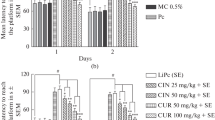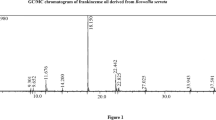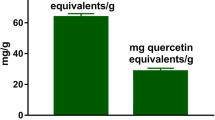Abstract
Oxidative stress has been implicated to play a role in epileptogenesis and pilocarpine-induced seizures. The present study aims to evaluate the antioxidant effects of curcumin, Nigella sativa oil (NSO) and valproate on the levels of malondialdehyde, nitric oxide, reduced glutathione and the activities of catalase, Na+, K+-ATPase and acetylcholinesterase in the hippocampus of pilocarpine-treated rats. The animal model of epilepsy was induced by pilocarpine and left for 22 days to establish the chronic phase of epilepsy. These animals were then treated with curcumin, NSO or valproate for 21 days. The data revealed evidence of oxidative stress in the hippocampus of pilocarpinized rats as indicated by the increased nitric oxide levels and the decreased glutathione levels and catalase activity. Moreover, a decrease in Na+, K+-ATPase activity and an increase in acetylcholinesterase activity occurred in the hippocampus after pilocarpine. Treatment with curcumin, NSO or valproate ameliorated most of the changes induced by pilocarpine and restored Na+, K+-ATPase activity in the hippocampus to control levels. This study reflects the promising anticonvulsant and potent antioxidant effects of curcumin and NSO in reducing oxidative stress, excitability and the induction of seizures in epileptic animals and improving some of the adverse effects of antiepileptic drugs.


Similar content being viewed by others
References
Gupta YK, Malhotra J (2000) Antiepileptic drug therapy in the twenty first century. Ind J Physiol Pharmacol 4:8–23
Schmitz B (2006) Effects of antiepileptic drugs on mood and behavior. Epilepsia 47:28s–33s
Frantseva MV, Perez VJL, Hwang PA et al (2000) Free radical production correlates with cell death in an in vitro model of epilepsy. Eur J Neurosci 12:1431–1439
Dal-Pizzol F, Klamt F, Vianna M et al (2000) Lipid peroxidation in hippocampus early and late after status epilepticus induced by pilocarpine or kainic acid in Wistar rats. Neurosci Lett 291:179–182
Halliwell B, Gutteridge JMC (1999) Free radicals in biology and medicine. Oxford Science Publications, London
Dröge W, Schipper HM (2007) Oxidative stress and aberrant signaling in aging and cognitive decline. Aging Cell 6:361–370
Korkmaz A, Oter S, Sadir S et al (2008) Exposure time related oxidative action of hyperbaric oxygen in rat brain. Neurochem Res 33:160–166
Turski WA, Cavalheiro EA, Schwarz M et al (1983) Limbic seizures produced by pilocarpine in rats: behavioural, electroencephalographic and neuropathological study. Behav. Brain Res 9:315–335
Turski L, Ikonomidou C, Turski WA et al (1989) Review: cholinergic mechanisms and epileptogenesis. The seizures induced by pilocarpine: a novel experimental model of intractable epilepsy. Synapse 3:154–171
Cavalheiro EA, Leite JP, Bortolotto ZA et al (1991) Long-term effects of pilocarpine in rats: structural damage of the brain triggers kindling and spontaneous recurrent seizures. Epilepsia 32:778–782
Cavalheiro EA, Fernandes MJ, Turski L et al (1994) Spontaneous recurrent seizures in rats: amino acid and monoamine determination in the hippocampus. Epilepsia 35:1–11
Yang F, Lim GP, Begum AN et al (2005) Curcumin inhibits formation of amyloid beta oligomers and fibrils, binds plaques, and reduces amyloid in vivo. J Biol Chem 280:5892–5901
Zhao J, Zhao Y, Zheng W et al (2008) Neuroprotective effect of curcumin on transient focal cerebral ischemia in rats. Brain Res 1229:224–232
Aggarwal BB, Harikumar KB (2009) Potential therapeutic effects of curcumin, the anti-inflammatory agent, against neurodegenerative, cardiovascular, pulmonary, metabolic, autoimmune and neoplastic diseases. Int J Biochem Cell Biol 41:40–59
Sumanont Y, Murakami Y, Tohda M et al (2007) Effects of manganese complexes of curcumin and diacetylcurcumin on kainic acid-induced neurotoxic responses in the rat hippocampus. Biol Pharm Bull 30:1732–1739
Shin HJ, Lee JY, Son E et al (2007) Curcumin attenuates the kainic acid-induced hippocampal cell death in mice. Neurosci Lett 416:49–54
Bharal N, Sahaya K, Jain S et al (2008) Curcumin has anticonvulsant activity on increasing current electroshock seizures in mice. Phytother Res 22:1660–1664
Jyoti A, Sethi P, Sharma D (2009) Curcumin protects against electrobehavioral progression of seizures in the iron-induced experimental model of epileptogenesis. Epilepsy Behav 14:300–308
Phillips JD (1992) Medicinal plants. Biologist 39:187–191
Ali BH, Blunden G (2003) Pharmacological and toxicological properties of Nigella sativa. Phytother Res 17:299–305
Kanter M, Coskun O, Uysal H (2006) The antioxidative and antihistaminic effect of Nigella sativa and its major constituent, thymoquinone on ethanol-induced gastric mucosal damage. Arch Toxicol 80:217–224
Kanter M, Coskun O, Kalayci M et al (2006) Neuroprotective effects of Nigella sativa on experimental spinal cord injury in rats. Hum Exp Toxicol 25:127–133
Ilhan A, Gurel A, Armutcu F et al (2005) Antiepileptogenic and antioxidant effects of Nigella sativa oil against pentylenetetrazol- induced kindling in mice. Neuropharmacology 49:456–464
Löscher W (1999) Valproate: a reappraisal of its pharmacodynamic properties and mechanisms of action. Prog Neurobiol 58:31–59
Johannessen CU (2000) Mechanisms of action of valproate: a commentatory. Neurochem Int 37:103–110
Löscher W (1993) Effects of the antiepileptic drug valproate on metabolism and function of inhibitory and excitatory amino acid in the brain. Neurochem Res 18:485–502
Williams MB, Jope RS (1994) Protein synthesis inhibitors attenuate seizures induced in rats by lithium plus pilocarpine. Exp Neurol 129:169–173
Ishrat T, Hoda MN, Khan MB et al (2009) Amelioration of cognitive deficits and neurodegeneration by curcumin in rat model of sporadic dementia of Alzheimer’s type (SDAT). Eur Neuropsychopharmacol 19:636–647
Abdel-Zaher AO, Abdel-Rahman MS, ELwasei FM (2010) Blockade of nitric oxide overproduction and oxidative stress by Nigella sativa oil attenuates morphine-induced tolerance and dependence in mice. Neurochem Res 35:1557–1565
Montgomery HAC, Dymock JF (1961) The determination of nitrite in water. Analyst 86:414–416
Ruiz-Larrea MB, Leal AM, Liza M et al (1994) Antioxidant effects of estradiol and 2-hydroxyestradiol on iron-induced lipid peroxidation of rat liver microsomes. Steroids 59:383–388
Beutler E, Duron O, Kelly BM (1963) Improved method for the determination of blood glutathione. J Lab Clin Med 61:882–888
Aebi H (1984) Catalase in vitro. Methods Enzymol 105:121–126
Ellman GL, Courtney KD, Andres V et al (1961) A new and rapid colorimetric determination of acetylcholinesterase activity. Biochem Pharmacol 7:88–95
Gorun V, Proinov I, Baltescu V et al (1978) Modified Ellman procedure for assay of cholinesterase in crude-enzymatic preparations. Anal Biochem 86:324–326
Bowler K, Tirri R (1974) The temperature characteristics of synaptic membrane ATPases from immature and adult rat brain. J Neurochem 23:611–613
Tsakiris S, Angelogianni P, Schulpis KH et al (2000) Protective effect of l-cysteine and glutathione on rat brain Na + , K + -ATPase inhibition induced by free radicals. Z Naturforsch 55:271–277
Arida RM, Scorza FA, Peres CA et al (1999) The course of untreated seizures in the pilocarpine model of epilepsy. Epilepsy Res 34:99–107
Veliskova J (2006) Behavioral characterization of seizures in rats. In: Pitkänen A, Schwartzkroin PA, Moshé SL (eds) Models of seizures and epilepsy. Burlington, Elsevier Academic Press, pp 601–611
Naffah-Mazzacoratti MG, Cavalheiro EA, Ferreira EC et al (2001) Superoxide dismutase, glutathione peroxidase activities and the hydroperoxide concentration are modified in the hippocampus of epileptic rats. Epilepsy Res 46:121–128
Freitas RM (2009) Investigation of oxidative stress involvement in hippocampus in epilepsy model induced by pilocarpine. Neurosci Lett 462:225–229
Yüksel A, Cengiz M, Seven M et al (2001) Changes in the antioxidant system in epileptic children receiving antiepileptic drugs: two year prospective studies. J Child Neurol 16:603–606
Michoulas A, Tong V, Teng XW et al (2006) Oxidative stress in children receiving valproic acid. J Pediatr 149:692–696
Verrotti A, Scardapane A, Franzoni E et al (2008) Increased oxidative stress in epileptic children treated with valproic acid. Epilepsy Res 78:171–177
Yis U, Seckin E, Kurul SH et al (2009) Effects of epilepsy and valproic acid on oxidant status in children with idiopathic epilepsy. Epilepsy Res 84:232–237
Mello LEAM, Cavalheiro EA, Tan AM et al (1993) Circuit mechanisms of seizures in the pilocarpine model of chronic epilepsy: cell loss and mossy fiber sprouting. Epilepsia 34:985–995
Scorza FA, Sanabria ER, Calderazzo L et al (1998) Glucose utilization during interictal intervals in an epilepsy model induced by pilocarpine: a qualitative study. Epilepsia 39:1041–1045
Masuda T, Maekawa T, Hidaka K et al (2001) Chemical studies on antioxidant mechanism of curcumin: analysis of oxidative coupling products from curcumin and linoleate. J Agr Food Chem 49:2539–2547
Kelloff GJ, Crowell JA, Hawk ET et al (1996) Strategy and planning for chemopreventive drug development: clinical development plan: curcumin. J Cell Biochem 26:72–85
Itoh K, Watanabe M, Yoshikawa K et al (2004) Magnetic resonance and biochemical studies during pentylenetetrazole-kindling development: the relationship between nitric oxide, neuronal nitric oxide synthase and seizures. Neuroscience 129:757–766
Kato N, Sato S, Yokoyoma H et al (2005) Sequential changes of nitric oxide levels in the temporal lobes of kainic acid-treated mice following application of nitric oxide synthase inhibitors and phenobarbital. Epilepsy Res 65:81–91
Przegalinski E, Baran L, Siwanowicz J (1996) The role of nitric oxide in chemically- and electrically-induced seizures in mice. Neurosci Lett 217:145–148
Rajasekaran K (2005) Seizure-induced oxidative stress in rat brain regions: blockade by nNOS inhibition. Pharmacol Biochem Behav 80:263–272
Rajasekaran K, Jayakumar R, Venkatachalam K (2003) Increased neuronal nitric oxide synthase (nNOS) activity triggers picrotoxin-induced seizures in rats and evidence for participation of nNOS mechanism in the action of antiepileptic drugs. Brain Res 979:85–97
Kovács R, Rabanus A, Otáhal J et al (2009) Endogenous nitric oxide is a key promoting factor for initiation of seizure-like events in hippocampal and entorhinal cortex slices. J Neurosci 29:8565–8577
Camacho-Barquero I, Villegas I, Sanchez-Calvo JM et al (2007) Curcumin, a Curcuma longa constituent, acts on MAPK p38 pathway modulating COX-2and iNOS expression in chronic experimental colitis. Int Immunopharmacol 7:333–342
Nanji AA, Jokelainen K, Tipoe GL et al (2003) Curcumin prevents alcohol-induced liver disease in rats by inhibiting the expression of NF-kappa B-dependent genes. Am. J. Physiol. Gastrointest. Liver Physiol 284:G321–G327
Sumanont Y, Murakami Y, Tohda M et al (2006) Prevention of kainic acid-induced changes in nitric oxide level and neuronal cell damage in the rat hippocampus by manganese complexes of curcumin and diacetylcurcumin. Life Sci 78:1884–1891
Mahmood MS, Gilani AH, Khwaja A et al (2003) The in vitro effect of aqueous extract of Nigella sativa seeds on nitric oxide production. Phytother Res 17:921–924
Safar MM, Abdallah DM, Arafa NM et al (2010) Magnesium supplementation enhances the anticonvulsant potential of valproate in pentylenetetrazol-treated rats. Brain Res 133:58–64
Brannan TS, Maker HS, Raes IP (1981) Regional distribution of catalase in the adult rat brain. J Neurochem 36:307–309
Matsuyama T (1997) Free radical-mediated cerebral damage after hypoxia/ischemia and stroke. In: Ter Horst GJ, Korf J (eds) Clinical pharmacology of cerebral ischemia. Totowa, NJ Humana Press, pp 153–184
Dringen R, Hirrlinger J (2003) Glutathione pathways in the brain. Biol Chem 384:505–516
Dringen R, Gutterer JM, Hirrlinger J (2000) Glutathione metabolism in brain. Metabolic interaction between astrocytes and neurons in the defense against reactive oxygen species. Eur J Biochem 267:4912–4916
Maher P (2005) The effects of stress and aging on glutathione metabolism. Ageing Res Rev 4:288–314
Freitas RM, Vasconcelos SMM, Souza FCF et al (2005) Oxidative stress in the hippocampus after pilocarpine-induced status epilepticus in Wistar rats. FEBS J 272:1307–1312
Sleven H, Gibbs EJ, Heales S et al (2006) Depletion of reduced glutathione precedes inactivation of mitochondrial enzymes following limbic status epilepticus in the rat hippocampus. Neurochem Int 48:75–82
Freitas RM (2010) Lipoic acid alters δ-aminolevulinic dehydratase, glutathione peroxidase and Na+, K+-ATPase activities and glutathione-reduced levels in rat hippocampus after pilocarpine-induced seizures. Cell Mol Neurobiol 30:381–387
Heales SJR, Bolanos JP (2002) Impairment of brain mitochondrial function by reactive nitrogen species: the role of glutathione in dictating susceptibility. Neurochem Int 40:469–474
Heales SJ, Davies SEC, Bates T, Clark JB (1995) Depletion of brain glutathione is accompanied by impaired mitochondrial function and decreased N-acetyl aspartate concentration. Neurochem Res 20:31–38
Jovanovic SV, Boone CW, Steenken S et al (2001) How curcumin works preferentially with water soluble antioxidants. J Am Chem Soc 123:3064–3068
Sun YM, Zhang HY, Chen DZ et al (2002) Theoretical elucidation on the antioxidant mechanism of curcumin: a DFT study. Org Lett 4:2909–29011
Awasthi S, Pandya U, Singhal SS et al (2000) Curcumin-glutathione interactions and the role of human glutathione s-tranferase P1–1. Chem Biol Interact 128:19–38
Dickinson DA, Iles KE, Zhang H et al (2003) Curcumin alters EpRE and AP-1 binding complexes and elevates glutamate-cysteine ligase gene expression. FASEB J 17:473–475
Cui J, Shao L, Young LT et al (2007) Role of glutathione in neuroprotective effects of mood stabilizing drugs lithium and valproate. Neuroscience 144:1447–1453
Hosseinzadeh H, Parvardeh S (2004) Anticonvulsant effects of thymoquinone, the major constituent of Nigella sativa seeds, in mice. Phytomedicine 11:56–64
Hajhashemi V, Ghannadi A, Jafarabadi H (2004) Black cumin seed essential oil, as a potent analgesic and antiinflammatory drug. Phytother Res 18:195–199
Burits M, Bucar F (2000) Antioxidant activity of Nigella sativa essential oil. Phytother Res 14:323–328
Badary OA, Al-Shabanah OA, Nagi MN et al (1998) Acute and subchronic toxicity of thymoquinone in mice. Drug Dev Res 44:56–61
El-Abhar HS, Abdallah DM, Saleh S (2003) Gastroprotective activity of Nigella sativa oil and its constituent, thymoquinone, against gastric mucosal injury induced by ischaemia/reperfusion in rats. J Ethnopharm 84:251–258
Rooney S, Ryan MF (2005) Modes of action of alpha-hederin and thymoquinone, active constituents of Nigella sativa, against HEp-2 cancer cells. Anticancer Res 25:4255–4259
Ullrich S, Zhang Y, Avram D et al (2007) Dexamethasone increases Na+/K+ ATPase activity in insulin secreting cells through SGK1. Biochem Biophys Res Commun 352:662–667
Fernandes MJS, Naffah-Mazzacoratti MG, Cavalheiro EA (1996) Na+, K+-ATPase activity in the rat hippocampus : a study in the pilocarpine model of epilepsy. Neurochem Int 28:497–500
Cowan CM, Cavalheiro EA (1980) Epilepsy and membrane Na+ K+- ATPase: changes in activity using an experimental model of epilepsy. Acta Physiol Latinoam 30:253–258
Walton NY, Nagy AK, Treiman DM (1998) Altered residual ATP content in rat brain cortex subcellular fractions following status epilepticus induced by lithium and pilocarpine. J Mol Neurosci 11:233–242
Muriel P, Sandoval G (2000) Nitric oxide and peroxynitrite anion modulate liver plasma membrane fluidity and Na + , K + -ATPase by nitric oxide. Biol Chem 4:333–342
Muriel C, Cataneda M, Ortega F (2003) Insights into the mechanism of erythrocyte Na+, K+ -ATPase inhibition by nitric oxide and peroxynitrite anion. J Appl Toxicol 23:275–278
Kaul S, Krishnakanth TP (1994) Effect of retinal deficiency and curcumin or turmeric feeding on brain Na+, K+- ATPase adenosine triphosphate activity. Mol Cell Biochem 137:101–107
Mattson MP (1998) Modification of ion homeostasis by lipid peroxidation: role of neuronal degeneration and adaptive plasticity. Trends Neurosci 21:53–57
Sharma D, Maurya AK, Singh R (1993) Age related decline in multiple unit action potentials of CA3 region of rat hippocampus: correlation with lipid peroxidation and lipofuscin concentration and the effect of centrophenoxine. Neurobiol Aging 14:319–330
Prall YG, Gambir KK, Ampy FR (1998) Acetylcholinesterase: an enzymatic marker of human red blood cell aging. Life Sci 63:177–184
Simonié A, Laginja J, Varljen J et al (2000) Lithium plus pilocarpine induced status epilepticus—biochemical changes. Neurosci Res 36:157–166
Freitas RM, Viana GSB, Fonteles MMF (2003) Striatal monoamines levels during status epilepticus. Rev Psiquiatr Clìn 30:76–79
Giovagnoli AR, Avanzini G (2006) Learning and memory impairment in patients with temporal lobe epilepsy: relation to the presence, type, and location of brain lesion. Epilepsia 40:904–911
Giacobini E (2000) Cholinesterase inhibitor therapy stabilizes symptoms of Alzheimer disease. Alzheimer Dis Assoc Disord 14:S3–S10
Jope RS, Simonato M, Lally K (1987) Acetylcholine content in rat brain is elevated by status epilepticus induced by lithium and pilocarpine. J Neurochem 49:944–951
Santos IM, Feitosa CM, Freitas RM (2009) Pilocarpine-induced seizures produce alterations in choline acetyltransferase and acetylcholinesterase activities and deficit memory in rats. Cell Mol Neurobiol 30:569–575
Meyer EM, Cooper JR (1981) Correlations between Na+-K+ ATPase activity and acetylcholine release in rat cortical synaptosomes. J Neurochem 36:467–475
Sato A, Sato Y, Uchida S (2004) Activation of the intracerebral cholinergic nerve fibers originating in the basal forebrain. Neurosci Lett 361:90–93
Das A, Shanker G, Nath C et al (2002) A comparative study rodents of standardized extracts of Bacopa monniera and ginkgo biloba anticholinesterase and cognitive enhancing activities. Pharmacol Biochem Behav 73:893–900
Sharma D, Sethi P, Hussain E et al (2009) Curcumin counteracts the aluminium-induced ageing-related alterations in oxidative stress, Na+, K+ ATPase and protein kinase C in adult and old rat brain regions. Biogerontology 10:489–502
Ahmed T, Gilani AH (2009) Inhibitory effect of curcuminoids on acetylcholinesterase activity and attenuation of scopolamine-induced amnesia may explain medicinal use of turmeric in Alzheimer’s disease. Pharmacol Biochem Behav 91:554–559
Huang M, Li Z, Ichikawa J et al (2006) Effects of divalproex and atypical antipsychotic drugs on dopamine and acetylcholine efflux in rat hippocampus and prefrontal cortex. Brain Res 1099:44–55
Brunbech L, Sabers A (2002) Effect of antiepileptic drugs on cognitive function in individuals with epilepsy; a comparative review of newer versus older agents. Drugs 62:593–604
Lutz MT, Helmstaedter C (2005) EpiTrack: tracking cognitive side effects of medication on attention and executive functions in patients with epilepsy. Epilepsy Behav 7:708–714
Coenen AML, Konings GMLG, Aldenkamp AP et al (1995) Effects of chronic use of carbamazepine and valproate on cognitive processes. J Epilepsy 8:250–254
Sgobio C, Ghiglieri V, Costa C et al (2010) Hippocampal synaptic plasticity, memory, and epilepsy: effects of long-term valproic acid treatment. Biol Psychiat 67:567–574
Author information
Authors and Affiliations
Corresponding author
Rights and permissions
About this article
Cite this article
Aboul Ezz, H.S., Khadrawy, Y.A. & Noor, N.A. The Neuroprotective Effect of Curcumin and Nigella sativa Oil Against Oxidative Stress in the Pilocarpine Model of Epilepsy: A Comparison with Valproate. Neurochem Res 36, 2195–2204 (2011). https://doi.org/10.1007/s11064-011-0544-9
Accepted:
Published:
Issue Date:
DOI: https://doi.org/10.1007/s11064-011-0544-9




